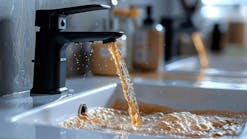A group of 400 native Peruvian Amazonians known as the Maijuna desperately searched for answers to help reduce their high child mortality rate when it became clear that their drinking water was one of the major culprits.
Once nomadic in nature, the Maijuna have, since the beginning of the 20th century, become a settler society that has congregated into four communities along four different rivers. This congregation, along with the domestication of animals and the practice of open defecation, has created more concentrated runoff into the surrounding rivers, contaminating the waters with bacteria that can cause fatal diarrheal diseases.
Searching for Support
Dr. Michael Gilmore, an ethnobiologist at George Mason University (GMU), has been working with the Maijuna for more than 13 years. After the Maijuna approached him about their water quality concerns, Gilmore sought help from local U.S. groups without any luck.
He then found GMU Engineers for International Development (GMU-EfID), a student-run organization that promotes better quality of life in developing countries through infrastructure improvement projects. The group had performed a water distribution project in the Andes of Peru in the summer of 2011. Gilmore contacted the group, and the two parties agreed to work with the Maijuna.
A Simple Solution
In January 2012, Leslie Temple and I, both GMU students at the time, traveled with Gilmore and Dr. Barry Liner, faculty advisor for GMU-EfID, to three Maijuna communities. In each village, a community meeting was conducted so that the Maijuna could explain the problem to the travel team and describe the outcome they were seeking.
It became clear that the Maijuna wanted clean water for their families. The travel team gathered information from many of the families and surroundings of each village and identified several solutions, including solar disinfection, rainwater collection, chemical disinfection, three-pot filtration, ceramic filtration and bio-slowsand filtration (biosand filtration).
The Maijuna and travel team agreed that, of all of these options, biosand filtration would best meet their needs in a sustainable manner. The team was able to find a sustainable source of appropriate sand in neighboring submerged Amazonian river sandbars.
Biosand Basics
Biosand filters are low tech and can be made with materials that are readily available to the Maijuna. A 30-gal food-grade plastic drum houses the filter medium. Pipe and fittings are placed inside the housing and medium, and exit near the top of the plastic drum, below the upper lip.
The pipe and fittings are first assembled and placed inside the plastic drum. A 10- to 20-cm layer of gravel is placed inside the container, followed by a 50- to 100-cm layer of sand. Water then is placed inside the barrel until the water level reaches just below the tap fitting of the pipe system. The system requires no pumps or mechanics to pump the water out of the filter; it relies on pressure head from the water level.
The water is left in the barrel undisturbed for three days to allow a complex biological film called schmutzdecke to grow underneath the first millimeter of sand. This layer purifies the water of most of the bacteria that cause diarrheal diseases.
Maintaining the biosand filter is easy. Once the container, gravel, pipe and fittings are purchased, the Maijuna have access to a natural sand bar in a local river that is optimal for the filter.
Roughly once every six months, the schmutzdecke layer will die and a new layer will need to be grown. The top layer of sand, approximately 1 cm thick, needs to be scraped off and removed, then the schmutzdecke layer can be regrown using the previously described techniques.
Once the sand layer has dropped to about 30 cm, all of the remaining sand needs to be removed and replaced with new sand after the gravel is washed and placed back into the container. The biosand filter is capable of filtering approximately 40 liters per day, enough for a typical Maijuna family.
Dramatic Differences
The implementation team traveled to the Maijuna lands in June 2012 to build the biosand filters and teach the communities about sanitation practices. Unfortunately, due to a 100-year storm event that caused massive flooding and made it nearly impossible to collect sand safely, the Maijuna were only able to collect enough to build one filter. The quality of sand that could be purchased from the closest city was not right for the filters.
The travel team built a biosand filter with the sand collected by the Maijuna, then ran tests on the filtered water with a turbidimeter and saw dramatic results. The team compared raw river water to filtered river water and purchased bottled water. The raw river water’s turbidity was approximately 35 ntu; the filtered river water at its lowest was 3.04 ntu; and the purchased bottled water was 2 ntu.
The Maijuna heard the team’s shouts of excitement at the favorable test results and came in from a soccer game to see what had happened. After taking several drinks of filtered river water, they all agreed that it was much clearer and tasted good. No biological tests were conducted due to time constraints; however, it was observed that the schmutzdecke layer had begun to form.
Continuing efforts with the Maijuna will ensure that every household will have its own biosand filter to provide clean water for each family. GMU-EfID plans to continue its work with the Maijuna to improve their quality of life.
Download: Here



